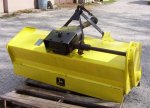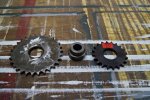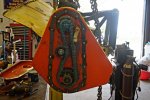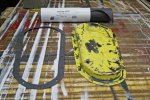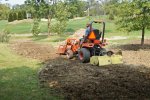Dieselbob
New member
Equipment
BX 2230, LA211 loader, 60†MMM, 2†wheel spacers, grille guard, gauges, bucket e
Ever since I got my BX, I have wanted a tiller, but the cost has been an impediment. Used four footers are EXTEMELY rare in my area, and even a new King Cutter is more than I wanted to invest, and what I REALLY wanted was a reverse tine unit, which meant springing for the $1800+ Land Pride.
Back in late August, I was at the huge Portland (IN) tractor show and swap meet. While walking the rows, I stumbled upon a decent looking four foot tiller in John Deere yellow. Once I inspected it, I realized it was for a JD 400 series garden tractor from the early 80's, and had a tractor specific three point mount, and a fine spline PTO. After looking at all the parts, I realized it was designed to run off the belly mower PTO and had a spate adapter gear box and drive shaft. It would take some work, but I was intrigued, ESPECIALLY when I realized it was reverse tine. The price was $600.00, but the owner offered it for $400.00 if I didn't want the belly mower drive adapter unit . I worked him down to $350.00 and hauled it home.
Mounting it to the Kubota was the simple part. All I had to do is ream out two of the existing lower mounting holes and install three point pins.
After doing some internet research, I discovered the fact that this tiller is meant to be driven off a 2000 RPM PTO. BIG problem. That meant the tiller would barely turn hooked to a standard 540 PTO. While checking gear box on the tiller, I discovered that it slowed down the output shaft on the tiller by 25%. I popped off the side cove on the tiller and found a 30 tooth sprocket connected to a 10 tooth sprocket by a #60 roller chain. a little quick math told me that if I could replace the 30 tooth sprocket with a 20 tooth sprocket, I could get the tiller within 5 RPM of it's design tine speed.
I removed the 30 tooth sprocket, and it had a specific splined hub that would be difficult if not impossible to match, but it was merely welded into a standard off the shelf sprocket. I carefully cut the welds and separated the two parts. A trip to Tractor Supply got me the needed 20 tooth sprocket and a new box of roller chain. I welded the old hub and the new sprocket and reassembled it with the new chain. I had a real problem getting the chain length right. Leave a link out, and you could not assemble it, add a link and it was a sloppy mess. I added a half link which helped, but it was STILL sloppier than seemed right, so I add a smaller idler sprocket. I didn't like the 20 bolts and nuts that held on the side cover, so I welded in bolts to make studs, cutting the cover removal time about 75%. The old gasket was shot, and JD parts for this unit seem to be scarce if not non-existent, so I made a new one out of gasket material. I want to paint the tiller to match the tractor, so since I had the chain drive side apart and clean, I went ahead and painted that part. I greased it all up and installed the cover.
The PTO shaft was several inches too short, and the spline size was wrong, so I went to my local driveline shop and bought a three foot section of the oddball rectangular PTO shaft with a yoke already welded on, a quick connect yoke to fit the standard 1 3/8"-6 spline tractor output shaft and a new u-joint. I assembled the shaft and cut down the shaft to get me the proper slip length.
Ten minutes before having to leave home for a cook out that turned out to be a surprise 50th birthday party for me (a week early) I fired the unit up. Everything went fine, so the next day I started tilling dirt. In just a short time, I have already tilled close to an acre of dirt, both fill dirt and virgin hard packed clay. I'm not going to tell you it works as will as an $1800.00 Land Pride, but it does work plenty good enough for me. It's a little light, so it wants to bounce in really hard dirt, but digs in and goes, and is very easy for the tractor to handle. Over the winter, it will get painted, and I need to make a cart to move it around, but for a total investment of $545.00, I'm VERY happy with it.
Back in late August, I was at the huge Portland (IN) tractor show and swap meet. While walking the rows, I stumbled upon a decent looking four foot tiller in John Deere yellow. Once I inspected it, I realized it was for a JD 400 series garden tractor from the early 80's, and had a tractor specific three point mount, and a fine spline PTO. After looking at all the parts, I realized it was designed to run off the belly mower PTO and had a spate adapter gear box and drive shaft. It would take some work, but I was intrigued, ESPECIALLY when I realized it was reverse tine. The price was $600.00, but the owner offered it for $400.00 if I didn't want the belly mower drive adapter unit . I worked him down to $350.00 and hauled it home.
Mounting it to the Kubota was the simple part. All I had to do is ream out two of the existing lower mounting holes and install three point pins.
After doing some internet research, I discovered the fact that this tiller is meant to be driven off a 2000 RPM PTO. BIG problem. That meant the tiller would barely turn hooked to a standard 540 PTO. While checking gear box on the tiller, I discovered that it slowed down the output shaft on the tiller by 25%. I popped off the side cove on the tiller and found a 30 tooth sprocket connected to a 10 tooth sprocket by a #60 roller chain. a little quick math told me that if I could replace the 30 tooth sprocket with a 20 tooth sprocket, I could get the tiller within 5 RPM of it's design tine speed.
I removed the 30 tooth sprocket, and it had a specific splined hub that would be difficult if not impossible to match, but it was merely welded into a standard off the shelf sprocket. I carefully cut the welds and separated the two parts. A trip to Tractor Supply got me the needed 20 tooth sprocket and a new box of roller chain. I welded the old hub and the new sprocket and reassembled it with the new chain. I had a real problem getting the chain length right. Leave a link out, and you could not assemble it, add a link and it was a sloppy mess. I added a half link which helped, but it was STILL sloppier than seemed right, so I add a smaller idler sprocket. I didn't like the 20 bolts and nuts that held on the side cover, so I welded in bolts to make studs, cutting the cover removal time about 75%. The old gasket was shot, and JD parts for this unit seem to be scarce if not non-existent, so I made a new one out of gasket material. I want to paint the tiller to match the tractor, so since I had the chain drive side apart and clean, I went ahead and painted that part. I greased it all up and installed the cover.
The PTO shaft was several inches too short, and the spline size was wrong, so I went to my local driveline shop and bought a three foot section of the oddball rectangular PTO shaft with a yoke already welded on, a quick connect yoke to fit the standard 1 3/8"-6 spline tractor output shaft and a new u-joint. I assembled the shaft and cut down the shaft to get me the proper slip length.
Ten minutes before having to leave home for a cook out that turned out to be a surprise 50th birthday party for me (a week early) I fired the unit up. Everything went fine, so the next day I started tilling dirt. In just a short time, I have already tilled close to an acre of dirt, both fill dirt and virgin hard packed clay. I'm not going to tell you it works as will as an $1800.00 Land Pride, but it does work plenty good enough for me. It's a little light, so it wants to bounce in really hard dirt, but digs in and goes, and is very easy for the tractor to handle. Over the winter, it will get painted, and I need to make a cart to move it around, but for a total investment of $545.00, I'm VERY happy with it.
Attachments
-
65.6 KB Views: 799
-
94 KB Views: 773
-
98.8 KB Views: 689
-
98.6 KB Views: 675
-
96.4 KB Views: 748


